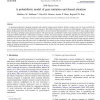108 search results - page 21 / 22 » Q: A Scenario Description Language for Interactive Agents |
86
Voted
JAPLL
2007
14 years 10 months ago
2007
History based models, introduced by Parikh and Ramanujam, provide a natural mathematical model of social interactive situations. These models offer a ”low level” description ...
103
Voted
NN
2006
Springer
14 years 11 months ago
2006
Springer
An important component of language acquisition and cognitive learning is gaze imitation. Infants as young as one year of age can follow the gaze of an adult to determine the objec...
102
Voted
DAGSTUHL
2003
15 years 9 days ago
2003
Abstract. Features provide extensions to a basic service, but in new systems users require much greater flexibility oriented towards their needs. Traditional features do not easil...
113
Voted
AIHC
2007
Springer
15 years 5 months ago
2007
Springer
Enabling machines to understand emotions and feelings of the human users in their natural language textual input during interaction is a challenging issue in Human Computing. Our w...
127
Voted
CLIMA
2006
15 years 10 days ago
2006
It is recognised that institutions are potentially powerful means for making agent interactions effective and efficient, but institutions will only really be useful when, as in oth...


